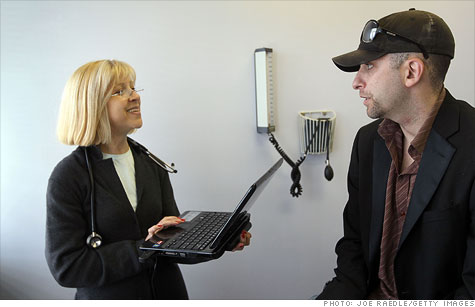National electronic health records network gets closer

An electronic health records network is becoming a reality, as the national attitude towards health IT is shifting towards acceptance.
NEW YORK (CNNMoney) -- The ambitious goal of setting up a nationwide, interconnected, private and secure electronic health records system isn't yet a reality -- but we're getting closer.
The 2009 Recovery Act, better known as the stimulus bill, set aside more than $20 billion for incentives to health care providers that deploy and meaningfully use certified electronic health records systems in their offices or hospitals. The first incentives are set to go out in the form of $22,000 Medicaid payments to early adopters within the next six months.
The problem with the current system is clear: Paper trails get lost, incorrect prescriptions get written, and doctors' time is wasted listening to patients explain their medical histories.Now, according to the Office of the National Coordinator for Health Information Technology (ONCHIT), the agency tasked with organizing the electronic health records project, 75% of hospitals have responded to surveys saying they are planning on investing in health information exchange services. ONCHIT presented the update at a Washington conference of health IT professionals on Thursday.
The government's solution is to make processes digital and connected. If a doctor's notes are entered into an electronic record, they can be accessed -- with a patient's permission -- by another medical professional. The system will alert doctors if a dosing or prescription seems awry. Human error is reduced to near zero. And doctors can diagnose problems faster and spend time seeing more patients.
Of course, that solution has its own set of problems. The cost of implementation is certainly a large factor, but privacy, usability, collaboration methods and training are also at issue.
But ONCHIT says that the tide has turned, and the concerns have become viewed as less of a turn-off and more of a necessary hurdle to overcome.
"We used to say the problem with this marketplace is that nobody wants to pay for information exchange," Farzad Mostashari, ONCHIT's director, said at the conference. "Well, all of a sudden now there's a lot of people who want to exchange information and coordinate care because the business case is there."
More than 100,000 rural primary care providers have now committed to achieving meaningful use of a networked digital health records system. That's a significant milestone, Mostashari said, because rural providers have been viewed as the most reluctant to change.
Thanks to the nation's changing attitude, the digitized health records business is booming, and vendors are beginning to release cheaper, faster products that operate in the cloud. The systems are also becoming also easier to use: Half the electronic medical records systems on the market now come with Apple iPad apps for doctors.
As the adoption hurdles are being jumped, the implementation barriers are the next to be overcome.
"The challenge is that you can become a meaningful user by yourself, but it's a team sport," said David Blumenthal, former ONCHIT director, at the conference. "You can't share information without collaboration."

